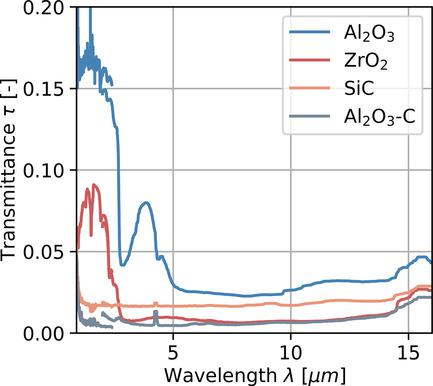当前位置:
X-MOL 学术
›
Adv. Eng. Mater.
›
论文详情
Our official English website, www.x-mol.net, welcomes your feedback! (Note: you will need to create a separate account there.)
Experimental and Simplified Predictive Determination of Extinction Coefficients of Ceramic Open-Cell Foams Used for Metal Melt Filtration
Advanced Engineering Materials ( IF 3.6 ) Pub Date : 2021-09-06 , DOI: 10.1002/adem.202100723 Lisa-Marie Heisig 1 , Katrin Markuske 1 , Eric Werzner 2 , Rhena Wulf 1 , Tobias M. Fieback 1
Advanced Engineering Materials ( IF 3.6 ) Pub Date : 2021-09-06 , DOI: 10.1002/adem.202100723 Lisa-Marie Heisig 1 , Katrin Markuske 1 , Eric Werzner 2 , Rhena Wulf 1 , Tobias M. Fieback 1
Affiliation

|
A main application area of ceramic open-cell foams is the foundry, where the porous media are used for conditioning and filtration of the melt flow. As characterization of heat transfer in such high-temperature applications requires consideration of thermal radiation, knowledge of the radiative properties of the foams is essential. Instead of elaborative measurements or simulations, empirical correlations often serve as a simple and fast method to predict extinction coefficients. However, significant differences up to 100 m−1 occur between calculated values of various models presented in the literature. Herein, it is aimed to characterize the radiation behavior of different ceramic foams experimentally and identify reliable, simple yet accurate methods for the prediction of extinction coefficients of these materials by comparison with experimental results. The influences of pore density (10 and 20 pores per inch [ppi]) and filter material (Al2O3, ZrO2, SiC, Al2O3−C) on the transmittance, reflectance, and extinction coefficients are investigated by spectroscopic measurements. Two models from the literature are determined, which are well suited to predict extinction coefficients with an average deviation of less than 20%. Furthermore, accurate estimation with an average deviation of 12% can be also achieved using a projection method based on computed tomography scans of the foams.
中文翻译:

用于金属熔体过滤的陶瓷开孔泡沫消光系数的实验和简化预测测定
陶瓷开孔泡沫的主要应用领域是铸造,其中多孔介质用于调节和过滤熔体流动。由于在这种高温应用中的热传递特性需要考虑热辐射,因此了解泡沫的辐射特性是必不可少的。经验相关性通常用作预测消光系数的简单快速的方法,而不是精细的测量或模拟。然而,显着差异高达 100 m -1发生在文献中提出的各种模型的计算值之间。本文旨在通过实验表征不同陶瓷泡沫的辐射行为,并通过与实验结果的比较确定可靠、简单而准确的方法来预测这些材料的消光系数。孔密度(每英寸 10 和 20 个孔 [ppi])和过滤材料(Al 2 O 3、ZrO 2、SiC、Al 2 O 3 )的影响-C) 通过光谱测量研究透射率、反射率和消光系数。确定了文献中的两个模型,它们非常适合预测平均偏差小于 20% 的消光系数。此外,使用基于泡沫计算机断层扫描的投影方法也可以实现平均偏差为 12% 的准确估计。
更新日期:2021-09-06
中文翻译:

用于金属熔体过滤的陶瓷开孔泡沫消光系数的实验和简化预测测定
陶瓷开孔泡沫的主要应用领域是铸造,其中多孔介质用于调节和过滤熔体流动。由于在这种高温应用中的热传递特性需要考虑热辐射,因此了解泡沫的辐射特性是必不可少的。经验相关性通常用作预测消光系数的简单快速的方法,而不是精细的测量或模拟。然而,显着差异高达 100 m -1发生在文献中提出的各种模型的计算值之间。本文旨在通过实验表征不同陶瓷泡沫的辐射行为,并通过与实验结果的比较确定可靠、简单而准确的方法来预测这些材料的消光系数。孔密度(每英寸 10 和 20 个孔 [ppi])和过滤材料(Al 2 O 3、ZrO 2、SiC、Al 2 O 3 )的影响-C) 通过光谱测量研究透射率、反射率和消光系数。确定了文献中的两个模型,它们非常适合预测平均偏差小于 20% 的消光系数。此外,使用基于泡沫计算机断层扫描的投影方法也可以实现平均偏差为 12% 的准确估计。



























 京公网安备 11010802027423号
京公网安备 11010802027423号